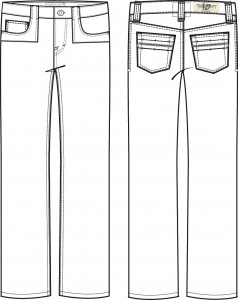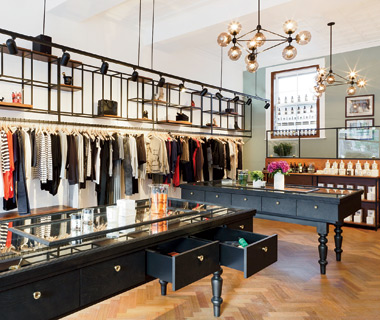While it’s pretty easy to come across a general description of what a Technical Designer is and what they do, I’ve found it’s a little more difficult to figure out what it is that they actually do at work.
Quite frankly, I’ve been to interviews where the person interviewing me doesn’t even really know what it is that a Technical Designer does, yet they know they need to hire one. That being said, this is how I, as a Technical Designer, like to explain it.
For starters, I don’t believe that limits should be set for a Technical Designer. Each company’s needs can vary greatly for a Technical Designer. One company may prefer to have their Technical Designer be more a part of their Design Team and another company may prefer to have them more a part of the Production Team with varying responsibilities.
The Technical Designer should in fact work as a liaison between Design and Production. They are essentially the engineers of fashion. Once a garment has been designed, someone has to figure out how to make it!
I’m going to go into the details of what most Technical Designers do and then follow up with any additional responsibilities that may be required of a Technical Designer. The fun part is that no two Technical Design jobs are ever the same and your learning opportunities are endless!
So here we go….
1. When you get a sketch from design – its go time! This may be a hand sketch or a sketch already done in Illustrator by design. If your sketch is done by hand – you will have to create a front and back flat sketch of the garment in Illustrator. You will have to work with the designer to ensure you have all the correct details – number of buttons, stitch gauges, thread colors, etc.
2. Now that you have your sketch, you will begin to create a Technical Package (also referred to as a Tech Pack, or TP). A Tech Pack’s basic pages are Sewing Details, Points of Measurement (or POM), Wash Description (mostly with denim), Label/Hangtag Placement, Bill of Materials (or BOM), and Packaging Instructions. All of these details are very important – the more detailed the better. Usually production is done in overseas factories where English is not their first language – so pictures, diagrams, and sketches are very helpful. (It also can save your butt if something comes in wrong – if it’s not in your TP or the TP was wrong, your company may incur a chargeback from the customer that bought it. If it was included in your TP and the TP was correct, then the factory must absorb the cost of the mistake.) Please see My Portfolio for what a finished Tech Pack looks like with all of the different pages.
3. After the Tech Pack has been created, it is emailed to the factory where production will take place. From the TP and pattern, the factory will create a first fit sample. When the first sample comes in, it is spec’d (measured) and if it is out of tolerance it is noted in the fit comments. Then, a fitting is scheduled with a fit model and any other adjustments are noted as well. For example – even if the specs were correct on the first sample, the designer may not like the look of the back pockets on a pair of pants once it is on the fit model and will want to adjust it. Once all of the fit comments have been made, the Technical Designer sends the comments to the factory and adjusts the Tech Pack accordingly. Usually fittings are attended by the designer, the TD, and the patternmaker. This fit process is repeated until the desired look and fit are achieved. Once it is approved, it is ready for production.
So, while the above is generally what Technical Designers do, it is definitely not limited to that. I’ve been in positions where in addition to the above, I am also helping the patternmaker check their patterns, calculating the shrinkage for fabrics, helping the design team out with sketching and designing and also creating embroideries. On the other hand, I’ve also done less than described above in other positions. At some companies I was not required to do fits at all. These companies had a Fit Technician that only handled fits while I only handled creating the Tech Packs.
If you have any other specific questions, don’t hesitate to leave me a comment and I’ll be sure to comment back!
Other Tech Designers – what process do you follow at work?







Hi there – thanks for this article, it was helpful! I’m working on creating a garment and have designed my first prototype. Although I am NOT a sewer/pattern maker or technical designer, I have enough information for another round of improvements. At what point do I bring in a technical designer to help with everything from design tweaks to the details you explain above? I don’t have a lot of money and am working out of my savings on this, so any advice you can give me would be helpful.
Thanks,
Helen
Hi Helen!
I would say that once you are ready for production, it can be helpful to have a Technical Designer – especially if you are producing overseas. If you are hiring a patternmaker/sewer locally, then it is fairly easy for you to explain to them how you would like your garment constructed, so it may not be totally necessary to hire a Technical Designer. If you find that you are having troubles getting your patternmaker/sewer to produce your idea properly, then it may be worth it to have a Technical Designer put together a tech pack so that all the details are laid out and there is no confusion.
I hope that helps and let me know if you have any questions about constructing your garment and I’ll see if I can help!
Good Luck!
Raquel
Hello Raquel-
Your entry was VERY helpful! I am interviewing for a technical design position- and i have more of a background in fashion design/graphic design, but not specifically fashion design- what types of things should i bring to my interview- or add into my portfolio to wow my potential employer? and what type of programs will i be potentially using? and do you have any addtional tips or suggestions?
*not specifically **technical design- I apologize
Hi Leah!
Congrats on your interview! Usually employers will want to see a sample tech pack and sample fit comments that you have done in the past. If you haven’t done any previously, you can use any design you’ve done in the past and create a tech pack for it and show sample fit notes of what you might do while fitting that garment. (See my Portfolio if you need to see what a sample tech pack looks like.)
As for programs – the main ones are usually Illustrator and Photoshop. Depending on the company they may use any of the following programs for their tech packs – WebPDM, Full Circle, and Excel.
I hope that helps and let me know if you have any other questions! Good luck and let me know how it goes! 🙂
-Raquel
Hi Raquel!
Great post on the daily functions of a technical designer. I am a Fashion School graduate (post-grad 2 years now) I’ve had some experience with technical design- POM’s, specs, fitting, and tech packs in school and after school. However, my experience post-grad has mostly been as an intern and for small businesses doing local manufacturing. I have been trying to break into a more corporate environment with technical design. Any advice on how to present my skills in an interview or resume situation. Technical design is definitely where I am destined to use my design aptitude!
Warmest Regards,
Lauren G
Hello Raquel,
What schools do you recomend for Technical Fashion Designers?
thanks
Hi Michael,
I went to FIDM in Los Angeles which I thought was a great school. I have also heard great things about FIT in New York. If you are looking for a more affordable school, I would check out L.A. Trade Tech. I personally believe that in Los Angeles companies are more focused on experience vs. education, but in New York and other areas education is just as important as experience.
I hope that helps!
-Raquel
Hello Raquel my name is Marian I patternmaker, I liked your note, and from what I read you work with pattern makers, would like to know that the program made its patterns if you do it on computers or on paper, I hope your answer thanks greetings from Argentina
Hi Mariana,
Pattern makers that I have always worked with use Gerber. I’m sure there are many other options, but that is the one that I am familiar with.
I hope that helps!
-Raquel
Hi Raquel.
I was working in mens wear brand as a designer and i actually see no differences between designer and technical designer. My responsibility as a designer included; technical drawing( i didn’t get sketches from creative designer. We did not even sketch. I spread my ideas directly on technical drawings and TP), fitting, meeting with fabric team, product manager etc. I think all of these thing are responsibility of designer. or no? I mean designer and technical designer is the same.
Thank you for your post.
Hi Andrew,
You are absolutely right in the fact that a designer should know the entire garment process from development to production. With that being said, there definitely is a distinct difference between a designer and a technical designer – especially if you are applying for jobs for one or the other. (You don’t want to apply to a tech design job, when in fact you really want to be a designer!) While responsibilities vary from company to company the main job responsibilities for me as a technical designer are construction, fit, pattern making, grading, and communicating all changes to the factory throughout the entire process. I have nothing to do with the actual concept design process i.e, choosing fabrics, trims, or the actual design of the garment, but we all work together to make sure the garment comes out right.
I hope that helps clear things up a bit!
-Raquel
I have a B.S. in clothing design and have been working as a seamstress and designer on a small scale for several years now. Having only recently learned about technical design, it seems to be the career I’ve been longing for. So here’s my question: do you feel that work in technical design requires a degree in the same or is it possible to learn the specifics on the job?
Thanks so much for your advice!
Hi Raquel,
I am a student in a business school with absolutely no fashion department at all. The job of technical designer interests me a lot. How to I go upon becoming one? Do I need to go to fashion school for it? Can I get in self-taught and with internship experience? I can’t really leave my school because that is where my scholarship is. Thanks!
Hi Raquel,
I wonder if you could help me. I love your article above which I came across as I was doing some research on the Internet. Basically I don’t have a background in fashion or design (my background is in law) but I have an idea for a swimwear range aimed specifically at females who have lost a lot of weight maybe following bariatric surgery, or maybe they gained a lot of weight during pregnancy and have then lost that weight but been left with the problem of excess skin. The swimwear on the market aimed at this type of client can sometimes seem a little aimed at the more mature ladies with flowery type patterns or spots or love hearts and also frills and stuff but what seems to be missing is an edgy, sexy range which is also supportive and still comfortable for those ladies who have gone from a big size to a smaller size but are not into frills, flowers or love hearts but infact want something a little different. My mum being one of those woman and also many other ladies at my mothers bariatric clinic as well as ladies in their 20s who dread going on holiday purely because of the swimwear issues. I have spoke to 2 technical designers who tell me they have over 20 years experience but who can’t seem to understand the range or vision which I am trying to put across. I’ve been told there is stuff out there already which would hide access skin and be supportive but it’s not the problem that there’s nothing out there. The problem is that what’s out there doesn’t suit every ladies taste and is not quite edgy, sexy, young and vibrant and fun enough – I wondered whether maybe you would any advice on what I should do next with my idea as I really don’t just want to give up on this. I want to give these ladies who want to be a little daring and edgy with their style the range for them so that they can feel fabulous on the beach or by the pool as well as feeling like the swimwear is top quality, fabulously supportive in all the right places while being daring and different to everything else already out there – I cant wait to hear from you. Any advice would be gratefully received. Thank you x
What exactly is the difference between a Technical Designer and a Patternmaker ?
Hi Jennifer,
A Technical Designer should have pattern knowledge because they will communicate pattern corrections and changes usually to overseas factories who have their own pattern makers and will correct the pattern. I’ve seen some Technical Design positions that are required to make the pattern corrections themselves and then send to overseas factories, but in my career I have only had to make paper corrections and send instructions on how to correct.
-Raquel
Hi Raquel,
I so appreciate this post! I am working on bringing a lingerie line to market, though I have no design background. Does a technical designer make the CAD (computer aided design) and also make a prototype?
According to what I read above, you mentioned a technical designer should be also be able to do a technical package, pattern making, fit and grading and communicating with the factory. Is it typical for a technical designer to be able to do all of this? I just want to make sure what to expect from 1 person.
Also Does the technical designer work with the fit model too to make sure the product fits right? I look forward to your response Racquel!
Hi Josee,
A technical designer should be able to create flat technical sketches for you in Illustrator with all sewing/construction information. They will put together a “tech pack” with all necessary information for a pattern maker to make a pattern and a sample maker to make the sample including initial development specs and grading based on your direction of what you want. Usually, a tech designer will also handle all of the fittings and communicate any changes to the pattern maker. A technical designer is very useful when dealing with overseas factories. If you are getting your product made domestically, you may be able to get away with working with just a pattern maker and sample maker, although sometimes it’s helpful to have a technical designer to help make sure all details are communicated correctly to the pattern maker.
I hope that helps out!
-Raquel
Hi Rachel,
Very helpful article! So if I understood correctly, the Technical Designer comes before the Pattern Maker in terms of getting from design to prototype? As in, designer, to Technical Designer to Pattern Maker (perhaps some back and forth), then sample? I have also seen that companies offer this whole process as a package (tech packs, pattern, first samples, etc) would something like this be a good option for someone starting their own line?
Thank you in advance!
I’m so sorry, I know your name is Raquel*. My apologies!
HI Raquel,
I found your article very helpful and thank you for being so simple and short in the explanation.
I have a bachelor degree as an engineer in line production BUT where I come from the practice for line production is not given the importance as it should be, therefore I have positioned myself in another place where I was more useful. I owned a fashion atelier for custom-made women’s clothing. Through the 3 years of working with all body types, a lot of wanna-have that dress situations, different materials I’ve gathered an experience in simple sketching, pattern making, cutting, sewing, embroidery, fitting, alterations and of course, the entrepreneur’s duties of day to day operations of running the business. The country where I come from is small, so the market is small, so one-man show position (what I did) is possible 🙂 even though demanding and exhausting.
Now, for 5 months living in the US (NY area) I’ve come to the knowledge that I have to find my greatest expertise – and that’s the technical design. So, now i am trying to make tech packs for all of my work (which is a LOT).
I have tried to zoom the samples of your portfolio but I couldn’t. Can you help me with that? And also can you show me another tech pack about a dress/skirt?
Thank you in advance.
Best regards,
Biljana
I learned so much from your article to all the comments I’ve read.
Thank you
HI Raquel,
I had several questions about patterning and fashion making.
Within the process of pattern making is there a digital version of the pattern that has the fabric over it or a digitalized final version of garment?
Could you use the same set of patterning and sewing instructions for garments that were very typical in style?
Are there any books you would recommend in terms of the process of garment making, specifically garment making for mass production.
You did a great job on this article. I will be sharing it with my high school students (giving you full credit, of course!).
Very helpful information
Hi Raquel,
Your article was so helpful. I studied my masters in Textiles and clothing.I worked in fashion industry overseas ( manufacturing unit) where my role was called Merchandiser and the responsibilities involved understanding the TP sent by the designer , following the instructions mentioned in the TP , explaining them to sample maker and getting them done , basically my role was to handle the entire order right from sample making costing till final shipment. Since my background is clothing and textiles, I have knowledge about the pattern making and technical design. But I did them manually. Can you please suggest the software that I should use to dear TP and where I can get them .
Also currently Iam in the US and want to restart my career. So based on my profile I described what is the role I should apply in the fashion industry here .
It would be extremely helpful if you suggest me .
Thanks a lot ,
Lakshmi
I am working with a pattern maker for jeans. Now that we are doing fit, it seems like I need a technical designer to help me talk to the pattern maker to make changes. I’m confused – what order should the tech person and the pattern maker come in? Does a design go to pattern, then tech or reverse or both?
I do have a question. Are there courses or programmes available to become a certified /qualified technical designer.